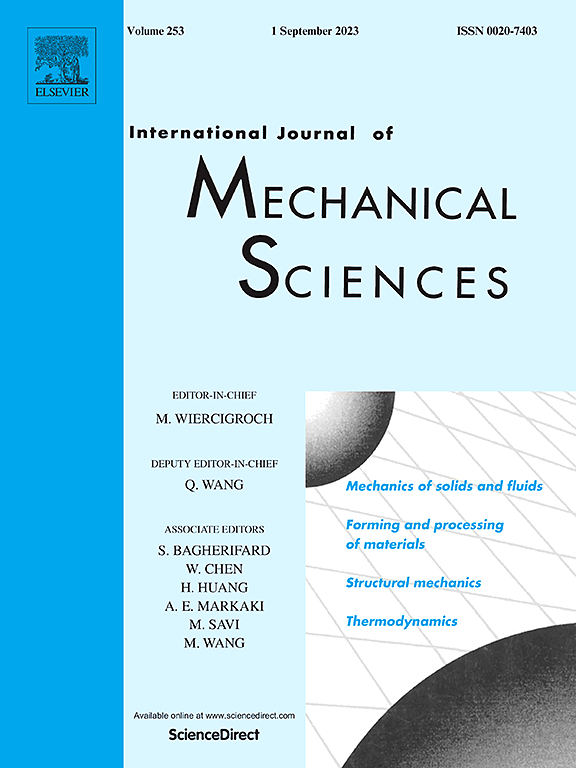Long-term Moisture Degradation of Rubber/Bamboo-Epoxy Composites
IF 7.1
1区 工程技术
Q1 ENGINEERING, MECHANICAL
International Journal of Mechanical Sciences
Pub Date : 2025-07-20
DOI:10.1016/j.ijmecsci.2025.110618
引用次数: 0
Abstract
This study presents a layered approach to understanding the environmental degradation of bamboo/epoxy/rubber bio-composites, focusing on the coupled effects of moisture diffusion, thermal exposure, and mechanical loading. Inspired by the structural concept of a conventional table tennis racket, a hybrid laminate assembly was developed using unidirectional bamboo fibers embedded in an epoxy matrix, with rubber skin layers introduced for enhanced damping and flexibility. The long-term durability of the composite was assessed through a combination of experimental investigation, analytical modeling, and environmental aging protocols. Moisture uptake behavior was characterized under three exposure conditions: 60% RH, 83.5% RH, and full water immersion at 30°C. Bamboo/epoxy composite substrate followed Fickian diffusion, while rubber layers exhibited Sequential Dual Fickian (SDF) behavior. Anisotropic absorption was observed, with longitudinal bamboo direction showing significantly higher uptake. Mechanical performance under compression was evaluated before and after aging, revealing the synergistic effects of hygrothermal and mechanical degradation. To capture this behavior, a hygro-thermomechanical extension of laminate theory was developed, enabling layer-wise prediction of stress distribution and diffusion kinetics under coupled environmental conditions. The findings offer new insights into the multi-physics degradation mechanisms of natural fiber composites and provide a framework for the design of durable, bio-inspired structural materials for sustainable engineering applications.橡胶/竹-环氧复合材料的长期湿降解研究
本研究提出了一种分层的方法来理解竹/环氧/橡胶生物复合材料的环境降解,重点关注水分扩散、热暴露和机械载荷的耦合效应。受传统乒乓球拍结构概念的启发,混合层压板组件的开发使用了嵌入在环氧基体中的单向竹纤维,并引入了橡胶表皮层,以增强阻尼和灵活性。通过实验调查、分析建模和环境老化协议的结合来评估复合材料的长期耐久性。在60% RH、83.5% RH和30°C全水浸泡三种暴露条件下,对吸湿行为进行了表征。竹材/环氧树脂复合基材表现为Fickian扩散,而橡胶层表现为顺序双Fickian扩散。各向异性吸收,竹材纵向吸收显著较高。对老化前后的压缩力学性能进行了评价,揭示了湿热和机械降解的协同效应。为了捕捉这种行为,开发了层压板理论的湿热力学扩展,从而能够在耦合环境条件下分层预测应力分布和扩散动力学。这些发现为天然纤维复合材料的多物理场降解机制提供了新的见解,并为可持续工程应用的耐用、仿生结构材料的设计提供了框架。
本文章由计算机程序翻译,如有差异,请以英文原文为准。
求助全文
约1分钟内获得全文
求助全文
来源期刊

International Journal of Mechanical Sciences
工程技术-工程:机械
CiteScore
12.80
自引率
17.80%
发文量
769
审稿时长
19 days
期刊介绍:
The International Journal of Mechanical Sciences (IJMS) serves as a global platform for the publication and dissemination of original research that contributes to a deeper scientific understanding of the fundamental disciplines within mechanical, civil, and material engineering.
The primary focus of IJMS is to showcase innovative and ground-breaking work that utilizes analytical and computational modeling techniques, such as Finite Element Method (FEM), Boundary Element Method (BEM), and mesh-free methods, among others. These modeling methods are applied to diverse fields including rigid-body mechanics (e.g., dynamics, vibration, stability), structural mechanics, metal forming, advanced materials (e.g., metals, composites, cellular, smart) behavior and applications, impact mechanics, strain localization, and other nonlinear effects (e.g., large deflections, plasticity, fracture).
Additionally, IJMS covers the realms of fluid mechanics (both external and internal flows), tribology, thermodynamics, and materials processing. These subjects collectively form the core of the journal's content.
In summary, IJMS provides a prestigious platform for researchers to present their original contributions, shedding light on analytical and computational modeling methods in various areas of mechanical engineering, as well as exploring the behavior and application of advanced materials, fluid mechanics, thermodynamics, and materials processing.
 求助内容:
求助内容: 应助结果提醒方式:
应助结果提醒方式:


